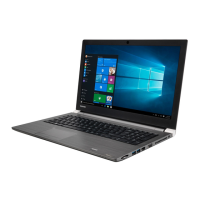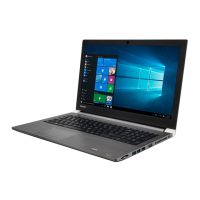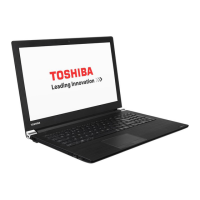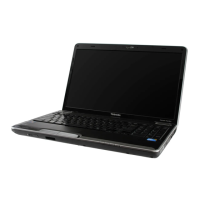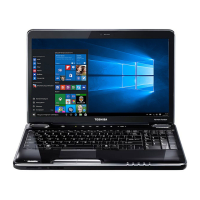
Do you have a question about the Toshiba Satellite A50-109 and is the answer not in the manual?
| RAM Type | DDR SDRAM |
|---|---|
| Storage | 40 GB HDD |
| Operating System | Windows XP Home Edition |
| Wireless | 802.11b/g |
| CPU Speed | 1.5 GHz |
| RAM | 256 MB |
| Display | 15.0 inch, 1024 x 768 pixels |
| Graphics | Intel Extreme Graphics 2 |
| Optical Drive | DVD-ROM/CD-RW |
| Ports | 3 x USB 2.0, VGA, RJ-45, RJ-11 |
| Processor | Intel Pentium M 715 (1.5 GHz) |
Details regarding copyright ownership and reproduction rights for the manual.
States the accuracy and limitations of the information provided in the manual.
Lists registered trademarks mentioned in the manual.
Provides warnings regarding modem usage and network compatibility.
Statement on the equipment's approval for pan-European telephone connection.
Details network compatibility and country-specific requirements.
Declaration of compliance with European directives.
Instructions for safe operation of optical disc drives, including laser warnings.
Global safety warnings and cautions for laser products and device operation.
Covers general safety, stress injury, heat, and impact precautions.
Details on PC card overheating, mobile phones, and CPU performance.
Information on RTC battery, CE compliance, and working environments.
Guidance on network connections and wireless LAN health risks.
Safety instructions and limitation of liability for wireless products.
Lists restrictions on the use of wireless products in specific environments.
Lists essential hardware items included with the computer.
Details on the computer's physical hardware components.
Lists preinstalled software and relevant documentation.
Highlights the main features of the computer, including processor and memory.
Describes memory options, storage drives (HDD, FDD, Optical).
Details on the display panel, graphics controller, and keyboard.
Information on various ports (USB, i.LINK) and communication devices (Modem, LAN).
Explains unique or advanced features like hot keys and power management.
Identifies components visible on the computer's front when the display is closed.
Details components located on the left side of the computer.
Details components located on the right side of the computer.
Identifies ports and indicators on the computer's back panel.
Details components located on the underside of the computer.
Identifies components visible on the computer's front when the display is open.
Explains the function of system status and keyboard indicator lights.
Describes optional external drives like USB floppy and optical media drives.
Details the AC adaptor, its function, and usage precautions.
Provides guidance on creating a comfortable and safe work environment.
Instructions for installing the battery pack and connecting the AC adaptor.
Steps for opening the display and powering on the computer.
Explains Hibernation and Standby modes for power saving.
Procedures for restarting the computer and restoring software.
Instructions on operating the computer's touch pad for navigation.
Guidance on connecting, loading, and removing floppy and optical media.
Details on audio controls and writing data to CDs/DVDs.
Tips on media care, sound system settings, and modem configuration.
Instructions for using Wireless LAN and LAN connections.
Procedures for cleaning the computer and managing heat.
Describes different types of keys: typewriter, function, and special keys.
Explains the use of F1-F12 keys and Fn key combinations.
Details various hot key combinations for system functions.
Covers Fn Sticky key, Windows keys, and Keypad overlay.
Explains power states, battery status, and indicator lights.
Describes battery types and essential care instructions.
Covers charging, monitoring capacity, extending battery life, and replacement.
Procedures for replacing battery packs and setting power-on passwords.
Details power-up modes, Windows utilities, and hot keys.
Steps to access and use the HW Setup utility.
Instructions for setting, deleting, and managing user passwords.
Configuration settings for devices like display and CPU.
Configuration for CPU modes and boot device priority.
Guidance on inserting and removing PC Cards.
Instructions for installing and removing memory modules.
Information on additional battery packs and AC adaptors.
Details on connecting external monitors, TVs, and i.LINK devices.
Instructions for using the security lock slot.
Guides on diagnosing and resolving computer problems.
Troubleshooting steps for system start-up, power, and battery problems.
Resolving issues with keyboard, display, disk drives, and peripherals.
Troubleshooting steps for modem, LAN, and wireless LAN connectivity.
Information on obtaining technical assistance from TOSHIBA.
Provides technical specifications for the computer's physical attributes.
Details environmental operating conditions and power specifications.
Technical details for the internal modem.
Explains the function of the display controller and supported resolutions.
Lists available video modes, resolutions, and color depths.
Instructions for installing the internal modem.
Instructions for removing the internal modem.
Details the specifications of the Wireless LAN card.
Explains radio characteristics and supported wireless channels.
Details the required specifications for AC power cords.
Lists certification agencies and shows plug shapes for different regions.
Advice on preventing theft and information needed for reporting.
Provides the form and details for registering a stolen computer.
